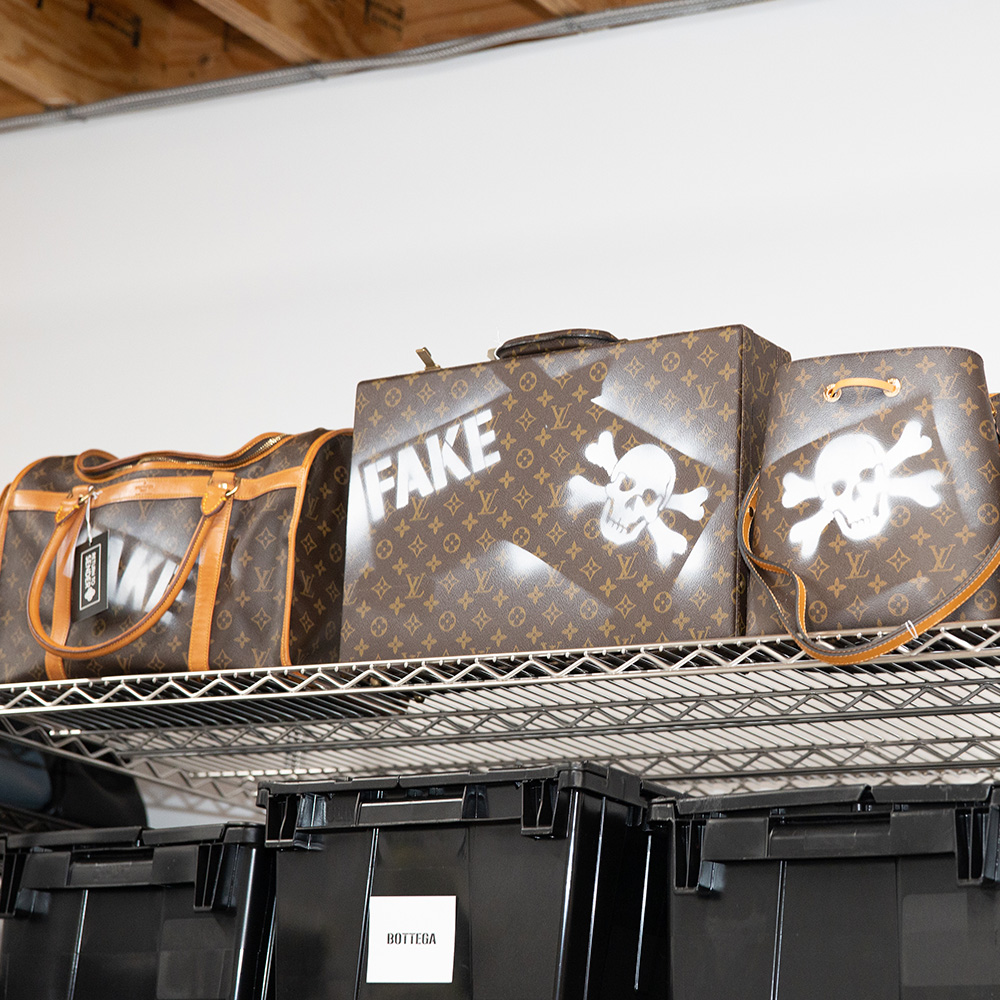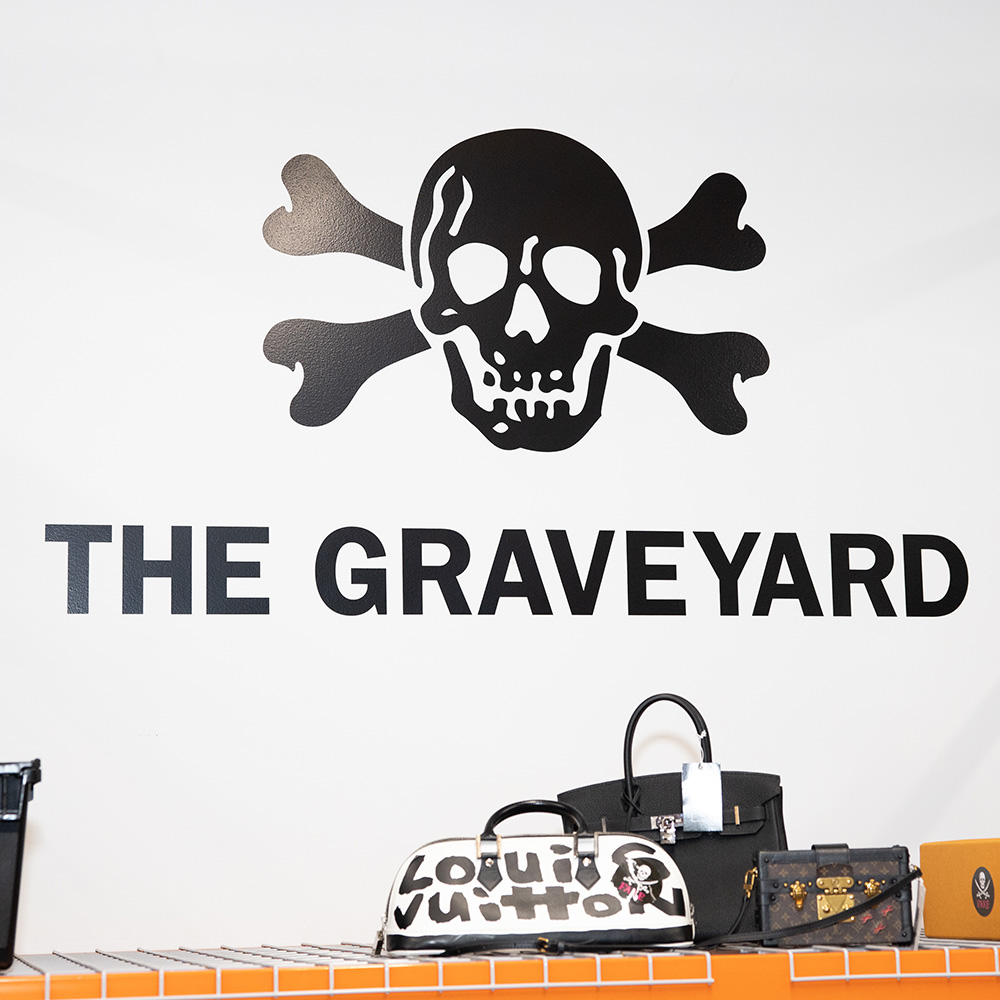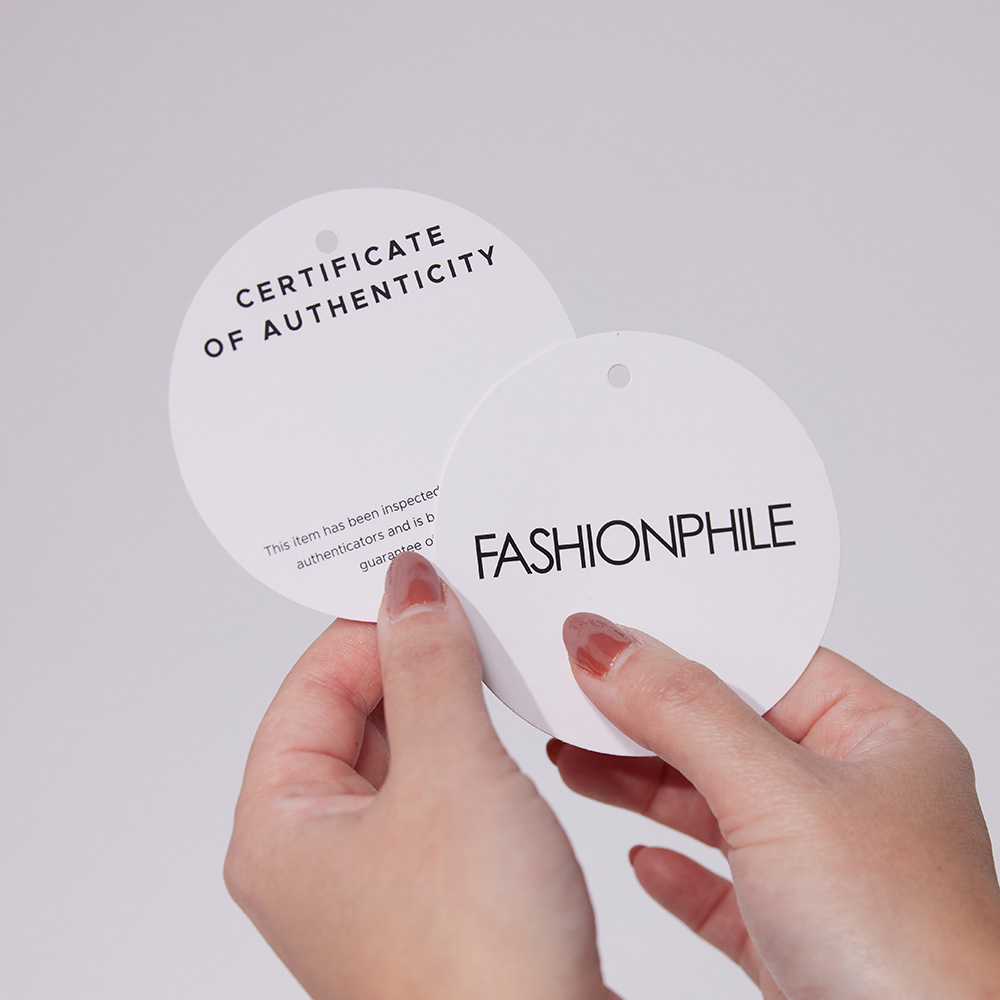Reality Check: The High Price of Low-Cost Fakes
Unpopular opinion: Wearing a counterfeit bag isn’t cute. Sporting a fake of a popular new shoe is not cool. Buying a counterfeit handbag is lame, not just because it supports intellectual property theft and undermines the integrity and reputation of the original brands, but because of the many nefarious activities that counterfeits support around the dark corners of the earth. As a society, we don’t talk about what exactly these nefarious activities are; it has become more taboo than showing off the fakes themselves. Given the power of a TikTok trend, popular opinions have actually been trending in the direction of normalizing fakes.
While replicas have been around almost as long as the brands, they’ve historically been looked down upon. Purchases were made in back alleys. And more often than not, the wearer tried to play off the fake, not brag about it. However, early in the pandemic, the TikTok algorithm gods signed off on “dupe culture” as a theme that seemed to quickly capture the attention of users, and get shared widely, inspiring others to recreate and put their own spin on the theme. Rather than slow down, this trend has seemed to gain momentum, with many people calling “dupes” the biggest trend of 2023.
Some of this is harmless. TikTok dupe culture applauds the finding of a cheaper, close copy of an original product. These items look similar to versions of a popular or high-end product and include anything from fashion items such as clothing, accessories, and handbags, to beauty and skincare products, electronics, and home goods. Buyers often seek out dupes as a more affordable alternative to the original, with the hope of achieving a similar look or function at a lower cost. Dupes are typically produced by other brands or manufacturers, and may closely resemble the design, packaging, or features of the original product, but at a lower price point. And when these items are merely “inspired by” the original, there is nothing wrong with that. Even the luxury brands themselves are inspired by styles that other brands produce. However, when those “dupes” include the outright illegal infringement of intellectual property rights of others, then a line has been crossed.
Counterfeit products are imitations that are made to look like the genuine article, with the intent to deceive consumers and profit from the reputation of the original brand. There are not only counterfeit designer goods but also fakes in currency, electronics, pirated software, and home goods like fake Duracell batteries and Tide Pods. Counterfeiting is a violation of the intellectual property rights of the owner and a violation is subject to legal action, including civil and criminal penalties, such as fines, imprisonment, and seizure of counterfeit goods. For these and other reasons that we will go into, buying and selling counterfeit accessories is absolutely unethical.
At FASHIONPHILE, we sell only accessories from ultra-luxury brands. These are not only the most highly sought-after, but they’re also the most highly counterfeited. TikTok can’t take all of the blame for this change in consumer behavior. Social media, in general, is greatly influencing purchase behavior today. The end result is that consumers are becoming more and more comfortable with buying counterfeits. You can read more about that here: Business of Fashion, CNBC, Buzzfeed. However, contrary to popular opinion, buying fakes is not just an innocent option. There are dark consequences behind buying counterfeit fashion.

At FASHIONPHILE, our number one value is, “we believe in authenticity.” This is not just a cute slogan we have up on the wall of our kitchen (although you will find it there). We have an absolute zero tolerance for the selling of fakes. The counterfeit industry is estimated to be a trillion-dollar underground market, fueling the behavior of both organized and disorganized criminals worldwide. Counterfeits are directly linked to human trafficking, child labor, prostitution, firearms and narcotics trade, extremist groups, terrorism, and more. A fake accessory in hand is not a victimless crime. The reality is that your unwary transaction funds atrocious ventures and groups that have alarming agendas. The following are actual examples of criminal acts that occur as a result of counterfeiting. This is what those dollars fund when you buy counterfeit accessories.
**Trigger warning: The following contains graphic descriptions of working conditions involving children and mentions of terrorist acts and extremist groups. Please peruse with caution.**
Fakes Support Human Trafficking
Also known today as “modern slavery,” human trafficking is real and directly connected to counterfeits. If you know something or need help, contact the National Human Trafficking Hotline.
Globally every year, millions of women, men, and most often children are trafficked for forced labor, sexual exploitation, prostitution, and even in some cases, organ removal. Counterfeits also fund the operations of countless sweatshops where fakes are made around the world. Sweatshops are commonly located in poor developing countries with grotesque working conditions, a lack of benefits, and unfair wages. Unfortunately, many vulnerable women and children are affected. It is estimated that 168 million children ages 5 to 14 are forced to work in such environments.
Legitimate companies take proactive steps to prioritize ethical sourcing and fair labor practices. They are more motivated to demonstrate their commitment to responsible business practices and to eliminate sweatshop production in their supply chains.
The same is not true of companies that are operating illegally and below the radar. In her book, Deluxe: How Luxury Lost Its Luster, Dana Thomas actually went undercover to visit some of these sweatshops in person. She told a harrowing tale:
“I remember walking into an assembly plant in Thailand a couple of years ago and seeing six or seven little children, all under 10 years old, sitting on the floor assembling counterfeit leather handbags,’ an investigator told me… ‘The owners had broken the children’s legs and tied the lower leg to the thigh so the bones wouldn’t mend. [They] did it because the children said they wanted to go outside and play.”
Others describe horrific scenes of children chained to sewing machines and workers locked and isolated in basements. Legitimate companies are forced to be transparent about their supply chain practices and to disclose information about their suppliers, labor practices, and working conditions. But illegal operations have no such safeguards. There is no one held accountable for their abysmal labor practices and unsafe working conditions. There are no audits of labor laws and zero human rights standards. This is one of the dark realities behind choosing fake accessories. But there’s more.
Fakes Aid in Firearms & Narcotics Trade
Counterfeiting supports organized crime. These black market operations funnel money into the illicit world of the illegal narcotics, firearms, and ammunition trade. According to a UK IP Crime Group survey, about 40% of respondents had worked on cases where counterfeiting was linked to drug crime, and 29% stated a connection between counterfeiting and overall organized crime.
Sources such as the UNODC (the United Nations Office on Drugs and Crime) also link criminal groups like the Mafia, Camorra in Europe and the Americas, and the Triads and Yakuza in Asia to counterfeits as a way to “diversify their product range.” Basically, this means that there are huge margins in the sales of counterfeits and that money is being used to support these activities. They act as the ideal decoy for smuggling drugs, firearms, and even people.
Illegal firearms and drug sales funded by counterfeits not only facilitate further violence and criminal activity but also pose more threats to society, increasing the likelihood of mass homicides, such as youth shootings that often target schools, malls, and movie theaters. But that’s hardly everything. Another dark reality is that fakes jeopardize global security.
Fakes Fund Terrorism
Traditionally, intellectual property crimes and terrorism have been considered separate, but now evidence actually shows that they are strongly linked. With improved technology and increasingly sophisticated financial infrastructures, terrorists engage in the benefits of counterfeit production (high profit, low risk) to aid their operations. The U.S. Senate, Committee on Homeland Security and Governmental Affairs reports that gangs, extremist groups, and foreign terrorist organizations, such as Hamas, the Taliban, and al Qaeda, continuously depend on the profits from counterfeits. This dirty money secures future operations, which include premeditated criminal activities from terrorist groups.
As if human trafficking, firearms, and narcotics trade, and terrorism aren’t enough reasons to never buy fakes again, there is also the health of our environment to consider.
Fakes Hurt the Planet
Counterfeits impact not only individuals but also the planet. Because of the clandestine nature of their manufacturing, no EPA guidelines or local laws are being followed, resulting in significant air and water pollution and affecting the health of humans, animals, and our environment. This year, the American Apparel & Footwear Association (AAFA) released a study that shed light on the risks posed by counterfeit goods flooding the market and their potential hazards for consumers. The study involved rigorous laboratory testing of counterfeit products for hazardous chemicals and heavy metals. Out of the 47 counterfeit products that underwent testing, including clothing, footwear, and other accessories, a concerning 17 products, accounting for 36.2 percent, did not meet stringent US product safety standards.
Furthermore, billions of dollars of counterfeits are seized annually by law enforcement. This contraband is most often destroyed through incineration, which has harmful environmental implications. The consequences of purchasing counterfeit accessories have a far-reaching ripple effect throughout our entire ecosystem.
Opting for authentic products from the beginning can help prevent these harmful effects. It is important to remember that the fact that counterfeit products are illegal actually accelerates these negative results. Choosing to purchase authentic items not only supports ethical production practices but actually protects the environment.
Buying & Selling Fakes Mean Fines, Prosecution, and Jail Time
Countries have different policies when it comes to the purchase, ownership, and public display of counterfeit items. For instance, in France, simply being seen in public carrying a fake handbag could result in years of imprisonment. French customs officers have the authority to seize any item they suspect to be fake and then to charge the individual with a criminal offense.
Perhaps because France is the leading country for the fashion industry in the world, it has been proactive and protective of intellectual property owners. In 2021, the French government seized and confiscated approximately 9.1 million counterfeit products. The same year, Nice customs destroyed 170,000 counterfeit items – a staggering 170% increase compared to the previous year. Legal battles like the case between LVMH and eBay have also been fought where French courts awarded victory and compensation to LVMH for the sale of counterfeit goods online. Even insiders aren’t immune, as we learned with the imprisonment of a group of former Hermes employees who were caught up in a counterfeit ring involving the production of fake Hermes bags.
In the United States, the Trademark Counterfeiting Act of 1984, specifically 18 U.S. Code Section 2320, governs violations related to selling counterfeit products, including copyright and trademark infringements, smuggling, and tax evasion. Under U.S. law, corporations can face fines of up to $15 million, and even individuals can face fines of up to $5 million and prison sentences of up to 10 years (or up to 20 years for repeat offenders) for knowingly distributing, wholesaling, or selling counterfeit merchandise. According to the U.S. Customs and Border Protection Agency, fake handbags rank as the second most seized category of counterfeit products. Notably, over 90% of all counterfeit seizures originate from e-commerce packages destined for U.S. addresses and are intercepted at international mail stations.

What FASHIONPHILE Is Doing to Help
At FASHIONPHILE, we believe in authenticity. We know that our customers trust us to get this right. That’s why they’re here, and we do all we can to earn that trust. We have spent literally decades building FASHIONPHILE University, where our own team of brand experts are trained in an apprentice-style program on specific brand authentication. There is no academic institution where one can be trained in these skills. Stanford doesn’t have a degree in Dior authentication. And Christian Dior, the brand, would never offer it either. So we developed a very robust program ourselves.
Our team of experts meticulously inspects each and every item before we purchase them. Our customers shop from us because of the trust they place in our expertise. Folks that are shopping FASHIONPHILE are looking to buy an authentic item from someone who is no longer using it. They cringe at even the thought of carrying a fake.
Years ago, we realized that we were being used as a “free authentication service.” But authentication is not free for us. We pay for the free shipping people use to ship a bag to us. We pay our skilled team to authenticate the item. And then, if the item is fake, we pay for the packaging and shipping to return it. But we obviously don’t want the fakes in the first place. So we implemented a $75 “in-person authentication and return shipping fee” in the case that an item is counterfeit and alert a would-be seller of this fee when they submit the item for a quote. If the item is authentic, the verification is free. But if not, we hold that item until they pay the fee. This slowed the increasingly steady flow of counterfeits coming in. Many times, when we let the seller know that the item is fake, we find that that person was scammed in the first place, and had no idea. So often, that innocent victim doesn’t want to pay the fee and considers the fake a “donation to science” as these end up in our “graveyard” and become a valuable source of knowledge for our authentication trainees. Our side-by-side, authentic vs. fake comparisons are excellent teaching tools.
Learn more about FASHIONPHILE’s accredited authentication process here.

What can you do?
You have the power to put a stop to the trillion-dollar underground counterfeit market. It’s easy. Just stop buying fakes. The cash flow in counterfeits is what’s feeding the monster. There was a time when if you didn’t have the money to shop from Chanel but loved the brand, a fake bag was the only way to even look like you were joining the club. That is not true today. You can buy authentic. At FASHIONPHILE, you have access to vintage and previously used authentic items at sometimes up to 90% off. The real deal is often cheaper than the fake. And when you shop from us, you can trust that you’re not only buying authentic, but you’re avoiding the many nefarious practices and dark realities that counterfeits support.
In summary, nothing good comes from buying counterfeit. In a world where one can be tempted by knockoffs with absurdly low price points and “super fakes” from illegal street vendors and via WhatsApp, it’s no wonder shoppers cave, for the pure sake of bypassing the high cost of the real thing in order to look like they own a luxury item. A so-called “deal” may sound appealing, but in reality, it just sugarcoats the dark and criminal world behind what your dollar funds when you buy fake accessories. These dirty dupes are directly linked to human trafficking, child labor, prostitution, firearms and narcotics trade, terrorism, etc. As hard as it is to open this dialogue, these dark realities are no secret. These are facts, and it’s happening right now. We hope this conversation can become as viral as the “dupe culture trend,” where everyone can be helped in understanding the severity of fakes and why buying authentic will always better serve you.
We’re pleased to see more public attempts to counteract the promotion and proliferation of counterfeit (we see you @TheFakeBirkinSlayer) and also so many professional resellers who are getting better and better at their attempts to keep fakes off the streets and internet:
- The RealReal
- Yoogis Closet
- StockX
- LePrix
- eBay
- Goat
- Rebag
April 20, 2023